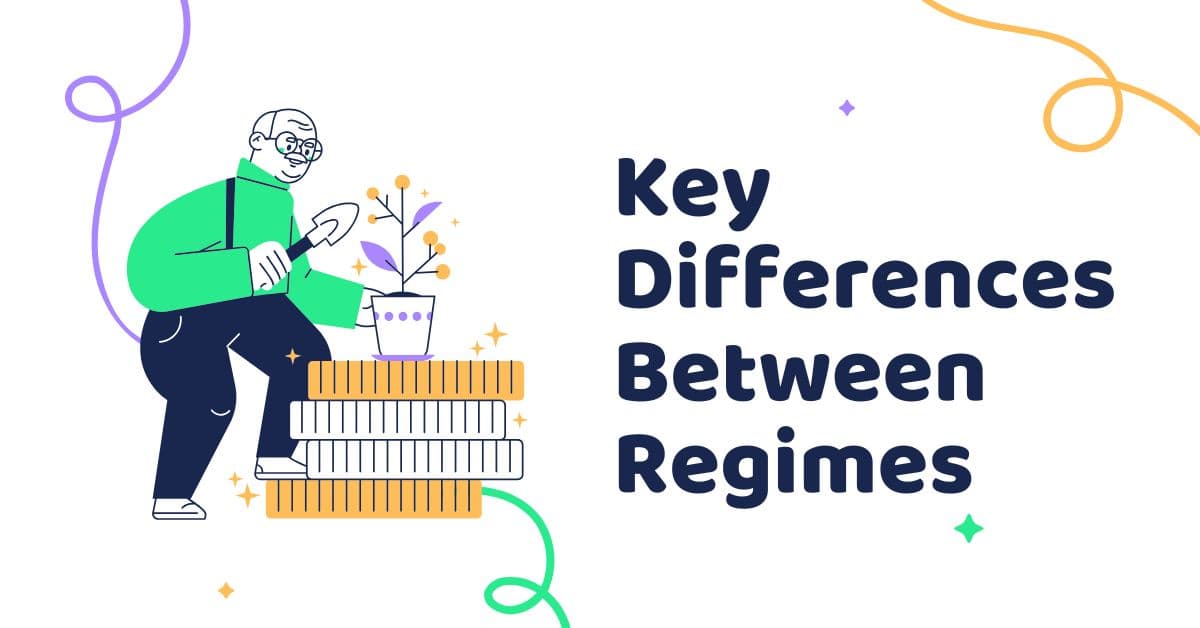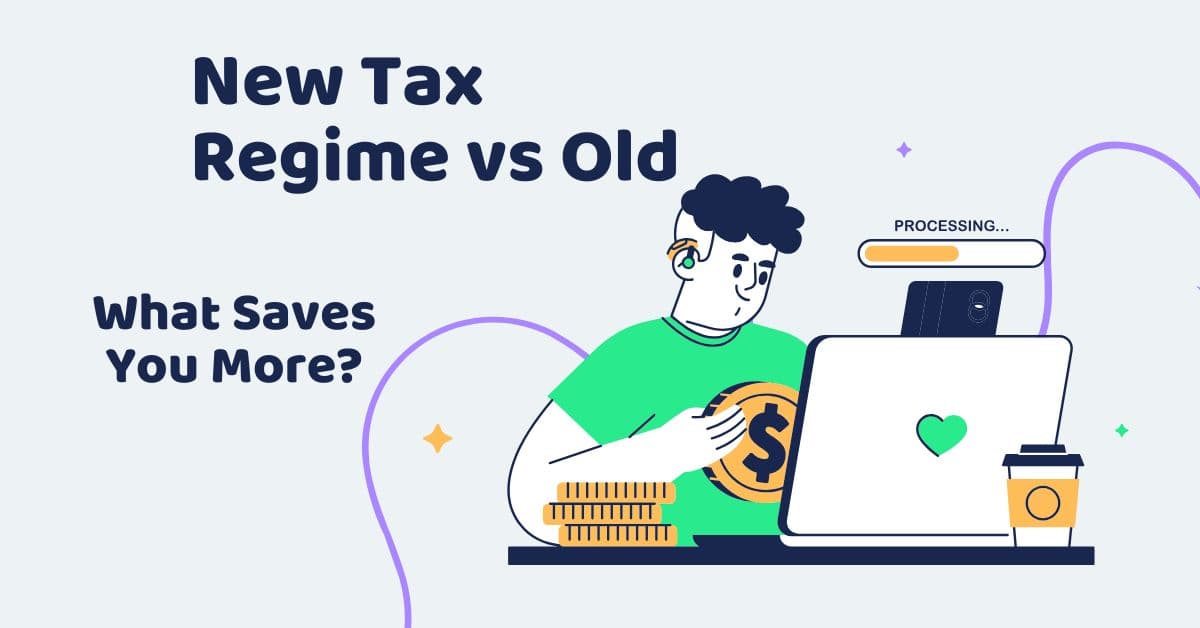New Tax Regime vs Old: For taxpayers looking to reduce their tax bill, selecting between India’s New Tax Regime and Old Tax Regime for the fiscal year 2024–25 (assessment year 2025–26) is crucial. The Old Tax Regime gives several exemptions but has higher rates, whereas the New Tax Regime, which was introduced in 2020, offers lower tax rates but restricts deductions. Many Indian taxpayers are reconsidering their choices in light of recent changes in the Union Budget 2024, which include a greater standard deduction and refund in the New Regime. In order to assist beginner and experienced filers in determining which regime saves more in 2025, this article offers a thorough analysis of the two regimes intended for Indian taxpayers. Our goal is to help you make an informed decision by examining tax slabs, refunds, deductions, and real-world situations.
An Overview of the Tax Laws
Old Tax Regime
Before 2020, the Old Tax Regime allowed taxpayers to lower their taxable income by claiming a number of exemptions and deductions. For people who have large assets or bills, such as mortgage loans, it’s perfect. Important characteristics include:

- Tax Slabs: Higher rates that differ according to age.
- Deductions: Deductions are available under sections such as HRA, 80D (health insurance), 24(b) (home loan interest up to ₹2 lakh), and 80C (₹1.5 lakh for investments like PPF, ELSS).
- Rebate Under Section 87A: For seniors and salaried persons, the standard deduction is ₹50,000.
- Marginal Relief: For residents with taxable incomes up to ₹5 lakh, the Section 87A rebate is ₹12,500, which eliminates their tax obligation.
Individuals Under 60 (Old Regime, FY 2024–25) Tax Slabs:
| Income Range (₹) | Income Range (₹) |
| Up to 2.5 lakh | 0 |
| 2.5 – 5 lakh | 5 |
| 5 – 10 lakh | 20 |
| Above 10 lakh | 30 |
The exemption limit for elderly adults (60-80 years) is ₹3 lakh, while super senior citizens (>80 years) are eligible for ₹5 lakh. A 4% Health and Education Cess is applied to the tax amount.
New Tax Regime
The New Tax Regime, which was introduced in 2020 and will be the default option in 2023, simplifies taxation by lowering rates while providing fewer deductions. Budget 2024’s updates make it more appealing to middle-income people. The key features include:
- Tax slabs: Lower rates applied uniformly across all age categories.
- Deductions: Salaried persons and pensioners are limited to a basic deduction of ₹75,000, while family pensioners may claim ₹25,000.
- Rebate Under Section 87A: The rebate under Section 87A has been increased to ₹60,000 for residents having taxable income of up to ₹12 lakh, resulting in zero tax payment.
- Marginal Relief: on minimise significant increases, marginal relief applies on incomes slightly over ₹12 lakh (up to ₹12.75 lakh for salaried individuals).
Tax slabs for all individuals (new regime, fiscal year 2024-25):
| Income Range (₹) | Tax Rate (%) |
| Up to 4 lakh | 0 |
| 4-8 lakh | 5 |
| 8-12 lakh | 10 |
| 12-16 lakh | 15 |
| 16-20 lakh | 20 |
| 20-24 lakh | 25 |
| Above 24 lakh | 30 |
For incomes slightly over ₹12 lakh, marginal relief guarantees tax equity, and a 4% Health and Education Cess is applicable.
Key Differences Between Regimes

| Aspect | Old Tax Regime | New Tax Regime |
| Tax Rates | Higher (5-30%) | Lower (0-30%) |
| Exemption Limit | ₹2.5 lakh (below 60), ₹3lakh (60-80), ₹5 lakh (>80) | ₹4 lakh (all ages) |
| Standard Deduction | ₹50,000 (salaried/pensioners) | ₹75,000 (salaried/pensioners),₹250,000 (family pensioners) |
| Rebate u/s 87A | ₹12,500 (income ≤ ₹5 lakh) | ₹60,000 (income ≤ ₹12 lakh) |
| Deductions | Multiple (80C, 80D,HRA,24(b), etc) | Limited (standard deduction only) |
| Flexibility | Annual choice for non-business income | Default; opt-out via ITR or Form 10-IEA (business income) |
Which Regime Will Save You More?
The decision is based on your income level and eligible deductions. Because of its lower rates and larger refund, the New Tax Regime is frequently more tax effective for persons with little to moderate deductions. The Old Tax Regime advantages persons who have significant deductions, such as house loan interest or considerable investments. Here’s the breakdown:

Low Income (up to ₹7 lakh)
- New Regime: Salaried persons earning up to ₹12.75 lakh are exempt from paying taxes under the new regime, which includes a ₹75,000 standard deduction and ₹60,000 refund. For example, a ₹7 lakh income results in $0 tax after deductions and refund.
- Old Regime: A ₹7 lakh income with ₹50,000 standard deduction and ₹1.5 lakh under Section 80C resulted in a taxable income of ₹5 lakh, with zero tax due to a ₹12,500 rebate.
- Verdict: Both regimes are tax-free, but the New Regime is easier and requires less documentation.
Medium Income: ₹10-15 Lakh
- New Regime: The new regime offers lower rates and a ₹60,000 refund for up to ₹12 lakh of taxable income. For a ₹10 lakh income, tax is zero after usual deductions and rebates.
- Old Regime: The old regime required considerable deductions (e.g., ₹2 lakh+) to compete. Even with ₹2 lakh deductions, tax rates may remain high.
- Verdict: The New Regime often saves more until deductions surpass ₹2.5 lakh.
High income (above ₹15 lakh)
- New Regime: The new tax regime allows for lower rates but no deductions over ₹75,000, limiting savings.
- Old Regime: Under the previous regime, high deductions (e.g., ₹4 lakh for house loan interest) might reduce taxable income and make it more tax-efficient.
- Verdict: The Old Regime may save more for people with large deductions.
Examples from Real Life
Example 1: Salaried Individual with ₹7 Lakh Income
- Profile: Priya, 30, earns ₹7 lakh yearly and invests ₹1.5 lakh under Section 80C (e.g., ELSS).
- Old Regime: In the old regime, taxable income was calculated as ₹7L – ₹50,000 (standard deduction) – ₹1.5L (80C), resulting in ₹5L. Tax = ₹12,500 (5% on ₹2.5L-₹5L), reduced to nil under Section 87A. Total tax is ₹0.
- New Regime: Under the new regime, the taxable income is ₹6.25L, calculated as ₹7L minus ₹75,000. Tax = ₹11,250 (5% on ₹2.25L), rebated to nil. Total tax is ₹0.
- Verdict: Both regimes end in no taxation, however the New Regime needs less paperwork.
Example 2: Salaried Individual with ₹12 Lakh Income
- Profile: Arjun, 35, earns ₹12 lakh after deducting ₹2 lakh (₹1.5L 80C, ₹50,000 80D).
- Old Regime: In the old regime, taxable income was ₹9.5L, calculated as ₹12L – ₹50,000 – ₹2L. Tax: ₹12,500 (5% on 2.5L-5L) + ₹90,000 (20% on 5L-9.5L) = ₹1,02,500 + 4% cess = ₹1,06,600.
- New Regime: Under the new regime, taxable income is ₹11.25L, calculated as ₹12L minus ₹75,000. Tax: ₹20,000 (5% on ₹4L-₹8L) + ₹32,500 (10% on ₹8L-₹11.25L) = ₹52,500 + 4% cess = ₹54,600, which is rebated to zero. Total tax is ₹0.
- Verdict: New Regime saves ₹1,06,600 with rebate.
Example 3: High earner with ₹20 lakh income
- Profile: Neha, 40, earns ₹20 lakh with ₹4 lakh deductions (₹1.5L 80C, ₹1L 80D, and ₹1.5L HRA).
- Old Regime: Under the previous regime, taxable income was ₹15.5L, calculated as ₹20L – ₹50,000 – ₹4L. Tax: ₹12,500 + ₹1,00,000 (20% on ₹5L-10L) + ₹1,65,000 (30% on ₹10L-15.5L) = ₹2,77,500 + 4% cess = ₹2,88,600.
- New Regime: Under the new regime, the taxable income is ₹19.25L, calculated as ₹20L minus ₹75,000. Tax: ₹20,000 + ₹40,000 (10% on ₹8L-₹12L) + ₹60,000 (15% on ₹12L-₹16L) + ₹65,000 (20% on ₹16L-₹19.25L) = ₹1,85,000 + 4% cess = ₹1,92,400.
- Verdict: New Regime saves ₹96,200 due to lower rates.
How to Select the Right Regime
- Calculate Deductions: Make a list of all available deductions for the old regime (e.g., 80C, 80D, HRA, home loan interest).
- Compare taxable income: To compare taxable income, subtract deductions from gross income in both regimes.
- Estimate Tax Liability: Apply the appropriate tax slabs and include the 4% cess. Apply any relevant rebates.
- Use Online Tools: Platforms such as ClearTax and Tax2win provide calculators to help you compare tax regimes.
- Consider Simplicity: The New Regime demands less documentation, which is suitable for people having few deductions.
- Consult a Tax Professional: In difficult circumstances, seek expert help from firms such as IndiaFilings.
Practical Tips for 2025
- Deadline to File: By September 15, 2025, you must file your income tax return (ITR) for non-business income, selecting your regime (Income Tax Department).
- Business Income: If you would rather use the Old Regime, opt out of the New Regime before the ITR deadline using Form 10-IEA.
- Record-keeping: Keep track of all receipts for Old Regime deductions (such as rent agreements and insurance fees).
- Keep an eye out for updates: For possible adjustments that might take effect in FY 2025–2026, look for Budget 2025 announcements in February.
Frequently Asked Questions (FAQs)
Is it possible for me to change regimes annually?
Yes, you have the option to file your ITR yearly for non-business income. Switching to the Old Regime for business revenue is only permitted once in a lifetime (revenue Tax Department).
Which deductions under the New Tax Regime are permitted?
According to ClearTax, the standard deduction for salaried persons is ₹75,000, while for family pensioners, it is ₹25,000.
The New Tax Regime is more advantageous to whom?
Because of the refund and reduced rates, those with earnings up to ₹12.75 lakh or with little deductions gain the most.
In the New Regime, how does marginal alleviation operate?
Tax is restricted to the excess above ₹12 lakh for taxable incomes between ₹12 lakh and ₹12.75 lakh, avoiding a significant rise (ETMoney).
Are high earners better off under the Old Regime?
It may be if deductions total more than ₹2.5–₹3 lakh, which would drastically lower taxable income.
Conclusion
With its ₹60,000 rebate and ₹75,000 standard deduction, the New Tax Regime frequently saves more for Indian taxpayers with earnings up to ₹12.75 lakh or modest deductions for FY 2024–2025. Those with significant deductions, such house loan interest or huge assets, benefit under the Old Tax Regime. Use programs like ClearTax to evaluate your tax burden under both regimes and seek individual tax counsel from a tax expert to find out which saves you the most. To maximise your savings and minimise taxes in 2025, begin your preparation today!
Disclaimer: Individual conditions determine tax estimates. Before selecting a regime, speak with a knowledgeable tax expert. This article is just meant to be instructive.
How to Use Amex Platinum Credit Card for Smart Tax Planning in 2025
Sensex Nifty Stock Market: Last-Minute Tax Moves!
Bank Nifty Today: Smart Tax Planning Moves You Shouldn’t Miss!
